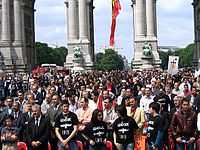Genocide Remembrance Day
| Genocide Remembrance Day | |
|---|---|
 | |
| Observed by | Armenia, Nagorno-Karabakh, California |
| Type | National |
| Significance | commemoration of Armenian Genocide |
| Date | 24 April |
| Next time | 24 April 2014 |
| Frequency | annual |
Genocide Remembrance Day (Armenian: Եղեռնի զոհերի հիշատակի օր) or Genocide Memorial day,[1] is a national holiday in Armenia and Nagorno-Karabakh Republic and is observed by Armenians in dispersed communities around the world on April 24.[1][2] It is held annually to commemorate the victims of the Armenian Genocide from 1915 to 1923. In Yerevan, the capital of Armenia, hundreds of thousands of people walk to the Tsitsernakaberd Genocide Memorial to lay flowers at the eternal flame.
History
The date 24 April commemorates the Armenian notables deported from the Ottoman capital in 1915, of hundreds of Armenian intellectuals and community leaders, most of whom would be executed, which was a precursor to the ensuing events.
The date was chosen by Lebanese Armenians to commemorate the 50th anniversary of the Genocide in 1965.[3] The same day witnessed illegal demonstrations staged by Armenians in Yerevan the capital of Soviet Armenia. The Armenian protests got out of control and calm was restored with difficulty.[4]
On 9 April 1975, the US House of Representatives passed Joint Resolution 148 designating 24 April as a National Day of Remembrance of Man’s Inhumanity to Man. The Resolution commemorated the victims of genocide, especially those of Armenian ancestry who succumbed to the genocide perpetrated in 1915, The resolution however failed to pass in the U.S. Senate Judiciary Committee due to President Gerald R. Ford’s strong opposition to what he saw as a threat to the country's strategic alliance with Turkey.[5]
Popularity of the day rose in diaspora as a result of anti-Turkish operations by Armenian groups such as the ASALA, and attendance of Genocide Day demonstrations rose in France from several hundreds to over 10,000 in 1981.[5]
Soviet Armenia formally adopted 24 April as a public day of commemoration in 1988.[6] In 1997 the California State Assembly declared 24 April as a Day of Remembrance for the Armenian Genocide of 1915–1923, and for the victims of the Sumgait Pogroms of 1988 and Baku Riots of 1990.[7]

The day is also chosen by Assyrian/Syriacs to commemorate the Assyrian Genocide especially in diaspora.
Monuments
Several monuments have been erected to commemorate the Armenian Genocide:
- Montebello Genocide Memorial
- Tsitsernakaberd Genocide Memorial
- Marseille Genocide Memorial
- List of Armenian Genocide memorials
See also
Notes
References
- Gunter, Michael M. (15 April 2011). Armenian History and the Question of Genocide. Palgrave Macmillan. ISBN 978-0-230-11059-5. Retrieved 23 April 2013.
- Bloxham, Donald (28 April 2005). The Great Game of Genocide: Imperialism, Nationalism, and the Destruction of the Ottoman Armenians. Oxford University Press. ISBN 978-0-19-150044-2. Retrieved 23 April 2013.
External links
- United Human Rights Watch
- Peace Pledge Union
- Armeniapedia
- Armenian National Institute
- Little Armenia Hollywood
- Factsheet: Armenian Genocide by Knights of Vartan Armenian Research Center, Dearborn, Michigan